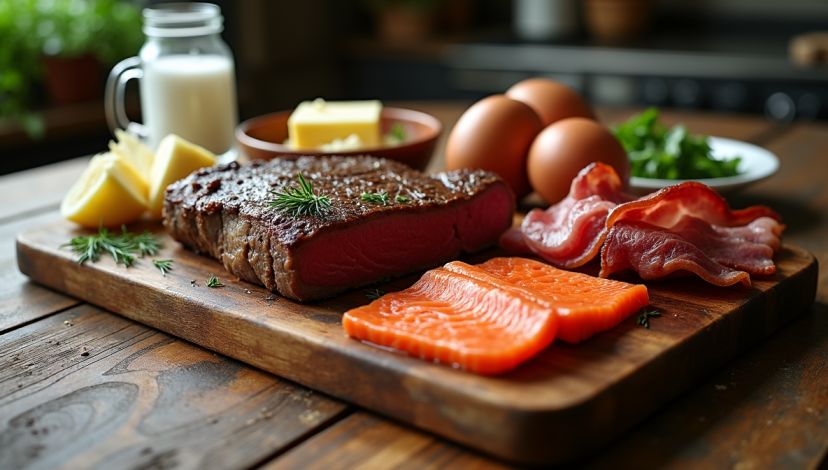The carnivore diet has become trendy because it is an intense, all-animal-foods diet, which claims to be easy and may lead to health benefits. If you’re curious about what can you eat on the carnivore diet, you’re not alone. This diet bans all foods of plant origin and pays complete attention to meat, fish, eggs, and a small amount of dairy products. It is the diet of choice of anyone who wants to lose weight, lower their inflammation, or address some chronic conditions by removing carbohydrates completely.
Exactly what can be eaten on a carnivore diet can make it or break it, so it is important to know the foods. This article is going to help you understand what you will eat, how to concentrate on quality animal-based products, and some helpful ideas on how to stick to the diet that is restrictive, but interesting to follow.
Key Takeaways:
- In the carnivore diet, all foods are of animal origin: beef, poultry, fish, eggs, and some dairy.
- Quality is important: grass-fed, wild-caught, and pasture-raised are more nutritious.
- Organ meats and other animal products are excluded because animal products lack the nutrients found in muscle meat.
Which Foods Are Permitted in the Carnivore Diet?
Simply put, the carnivore diet involves consuming nothing but food of animal origin. This entails removing all fruits, vegetables, grains, nuts, and seeds. And this is a step-by-step description of permitted foods:
Meat and chicken
- Beef: cuts of all kinds, such as ribeye, sirloin, brisket, chuck roast, and ground beef.
- Pork: Pork chops, ribs, pork shoulder, bacon, and sausage (preferably without any additives).
- Lamb: Lamb chops, lamb shanks, and ground lamb.
- Chicken and Turkey: Breast, thighs, wings, and drumsticks, as well as whole birds.
Fish and Seafood
- Fatty fish full of omega-3s like salmon, trout, mackerel, and sardines etc.
- Shellfish such as shrimp, oysters, clams, crab, mussels, and lobster.
Organ Meats
- Meats high in nutrients are thoroughly promoted, and these include organ meats:
- Liver, kidneys, heart, tongue, oxtail, brain, and sweetbreads.
The eggs and Dairy.
- Eggs are a staple and can be freely consumed.
- Dairy, including hard cheeses, heavy cream, butter, and yogurt, is firable, whether tolerated, to small quantities. The raw and whole milk and milk products are preferred.
Cooking Oils and Fats
- Cooking is done using animal fats such as tallow, lard, duck fat, and clarified butter (ghee).
- And to this add fat and flavour by means of butter and heavy cream.
Seasonings
- Plant-based seasoning should be kept to a minimum, including salt and pepper, though there are certain spices which can be used, like paprika, cumin, and garlic powder.
Note: Carnivore diet is restrictive, but by including a large assortment of animal foods, in particular, organ meats, a more balanced set of nutrients will be consumed, and the threat of shortages decreases.
Differences in the Foods of the Carnivore Diet: Nutrition Differences
And to assist you learn what nutrition the most numerous carnivore diet foods contain, here is a comparison table demonstrating the main macro and micro elements in the typical servings of them:
| Food Item | Protein (g) | Fat (g) | Calories | Key Nutrients |
|---|---|---|---|---|
| Ribeye Steak (4 oz) | 28 | 22 | 310 | Iron, B12, Zinc, Creatine |
| Salmon (4 oz) | 23 | 13 | 230 | Omega-3, Vitamin D, Selenium |
| Chicken Thigh (4 oz) | 26 | 10 | 210 | Niacin, Phosphorus, Selenium |
| Beef Liver (3 oz) | 22 | 5 | 135 | Vitamin A, Folate, Iron, Copper |
| Eggs (1 large) | 6 | 5 | 70 | Choline, Vitamin D, and B12 |
| Hard Cheese (1 oz) | 7 | 9 | 110 | Calcium, Vitamin A, and Protein |
Table caption: Foods most frequently used in carnivore-based diets compared in terms of their nutritional value, focusing on protein, fat, calories, and main micronutrients.
ALT text: Table with features of steak, salmon, chicken, liver, eggs, and cheese in proteins, fat, calories, and nutrients.
This should explain the preference of fatty cuts and organ meat; they contain many vital vitamins and minerals that usually do not exist in lean muscle meat alone.
What can you eat on the carnivore diet, and which are the best animal products to buy that will improve your health?
Animal foods are not all created alike. Your animal products and meat quality can have a great influence on your health results in the carnivore diet.
The relevance of Quality: Why Quality Matters
- Compared to conventional rearing of animals, grass-fed and pasture-raised meat have high levels of omega-3 fatty acids and antioxidants.
- Fish caught in the wild tend to have smaller amounts of contaminants and harmful fats, whereas the use of farmed fish is associated with having larger amounts of significant fats.
- There are more nutrients preserved and less exposure to hormones and antibiotics in organic and raw dairy products.
- Expert Insight
Dr. Shawn Baker, a major promoter of the carnivore diet, appears to stress on the quality of animal food:
Consumption of nutrient-rich, ethically produced animal products guarantees maximum proficiency of vitamins and minerals required by your body in addition to keeping away damaging conjectures.
Practical Tips
- Find labels that say, grass-fed, pasture-raised, or wild-caught.
- When you can, purchase the produce of local farmers or farms you know are producing good produce.
- Shun processed meat, loads of fillers or sugar, or preservatives.
This is in reminder: The nutritional intake of high-quality animal products can be used to promote long-term health on the carnivore diet.
What can you eat on the carnivore diet, and how did it transform one health journey in a real-life example?
Jane is a 35-year-old patient having autoimmune complications who had been experiencing problems with inflammation and digestion over several years. Switching to the carnivore diet and eating red meat, organ meat, eggs, and fatty fish, she found numerous improvements in a matter of weeks.
She attributes the loss of plant toxins and anti-nutrients and the intake of animal food sources that are rich in nutrients to her losing her symptoms. Jane also used fatty cuts and bone broth to stay energized and keep full.
She is one of a large number of anecdotal reports of the carnivore diet as a possible method of curing chronic conditions, but there is little clinical research to support these claims.
What can you eat on the carnivore diet, and what types of problems might arise, with solutions to overcome them?
Though the carnivore diet is simple at its core, it has its challenges:
- Deficiencies of nutrients: People consume low amounts of vitamin C and fiber when they exclude vegetable foods. Organ meats provide some of the vitamins, but they might still need to take supplements.
- Social and Practical: It is not easy to eat out or socialize because of the reduced choice of food. It is important to plan ahead.
- Phase of Adaptation: Others experience fatigue and changes in digestion as initial symptoms, commonly known as the keto flu.
Solutions
- Take different kinds of organ meat on a regular basis.
- Have minerals and gut health using bone broth.
- Hydrate and take electrolytes into consideration.
- It should be initiated by consulting a medical practitioner.
Carnivore Diet as compared to. Other Low-Carb Diets: A Comparison in a Short Time
| Feature | Carnivore Diet | Keto Diet | Paleo Diet |
|---|---|---|---|
| Allowed Foods | Only animal products | Animal + low-carb plant foods | Animal + fruits, veggies, nuts |
| Carb Intake | Nearly zero | Very low (<50g/day) | Moderate (varies) |
| Fiber Intake | None | Low to moderate | Moderate to high |
| Emphasis on Fat | Moderate to high (animal fat) | High (healthy fats included) | Moderate (varied fat sources) |
| Research Available | Limited | Growing body of evidence | Well-studied |
| Potential Risks | Nutrient deficiencies, high LDL | Keto flu, electrolyte imbalance | No major with balanced intake |
Table Caption: A table that compares carnivore, keto, and paleo diet with the aspects of food range, carbohydrate, and fiber content, as well as the level of research.
The ALT text: The table of the comparison of carnivore, keto, and paleo diets according to the permitted food and carbs consumption, fiber, and fat focus, research, and limitations.
Conclusion
Understanding what can you eat on the carnivore diet is the first step toward successfully adopting this unique eating plan. The diet concentrates on animal-based products, such as beef, poultry, fish, eggs, and minimal dairy, but pays a great attention to nutrient-dense sources of these products known as organ meats and the best quality sources.
Some individuals may benefit from a carnivore diet through weight loss and reduced inflammation, but they must plan it carefully to avoid nutrient deficiencies and health risks. Animal products obtained using the grass-fed, wild-caught, and pasture-raised method will improve the nutritional content of the diet.
In case you want to take this diet, you first should begin by slowly adding allowed foods, check your health condition, and also go to an attending physician. To find out additional information about similar diets, refer to our article about: What Vegetables Are Keto Friendly: Best Low-Carb Choices
FAQs
Q1: Is it possible to take vegetables on a carnivore diet?
A: No, a carnivore diet does not contain any food of plant origin but is limited to the products of animal origin only.
Q2: Do eggs feature in a carnivore diet?
A: Yes, eggs are staple foods and that can be consumed in an unlimited way on the carnivore diet.
Q3: Is dairy allowed on a carnivore diet?
A: Little dairy is permitted in small quantities, and it should include hard cheese, butter, and heavy cream, depending on your tolerance.
Q4: Which are the most suitable meat cuts in a carnivore diet?
A: Energy and satiety is better suited to fatty cuts such as ribeye, brisket, and ground beef.
Q5: Does bone broth belong to the carnivore diet?
A: Yes, I will recommend bone broth with hydration and other nutrients such as collagen and minerals.




